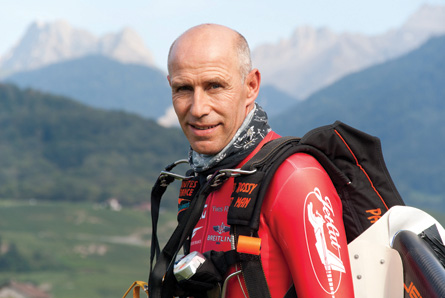Yves Rossy, aka Jet Man, is an airline pilot who want to fulfil his dream of making personal powered flight a reality, using a custom wing, thrust from four model aircraft engines, and his body as the control surfaces.
When were you first interested in aviation?
I've always wanted to fly since I was a child. My inspiration has always been to make my dream come true.
Describe your career path.
I did an apprenticeship in engineering and was a Mirage III pilot. I was flying a supersonic fighter jet for 17 years while indulging my love of historic aircraft in my spare time. After six years as a professional fighter pilot, I became co-pilot for Swissair, on DC-9 and 747 aircraft. I am currently captain on an Airbus A320 with Swiss International Air Lines, and am on sabbatical leave to devote all my free time to my passion and lifelong project: flying like a bird with the minimum of instruments but with jet power to allow me to soar in the sky.
What was your first idea for a flying adventure?
I had the idea to build a wing after discovering skysurfing when I was 30. I enjoyed it and I wanted to keep the same feeling, but with a real flight instead of a fall. At first I could only glide with the wing. The next step was to motorise the wing, so I went to JetCat in Germany, a world leader in model jet technology, and as my first and most important sponsor they made it possible for the wing to have power and engines.
 |
|---|
Yves Rossy |
How have you developed the special Jet Man suit?
The first wing was based on an aerodynamic model from Kiev University in Ukraine. It was an inflatable wing, which over the years - through trial and error - I have modified into a solid wing.
I have developed about 15 prototypes over the past 15 years! The first time I used a wing was in 1992. I have been working on this prototype (with four engines) for more than three years and I never stop trying to improve it. A big step forward was achieved after the wing tunnel tests with RUAG Aerospace in 2008. A new wing shape was developed and built by their team, improving stability and agility as well as lowering weight, leading to the current wing I now have on my back.
What are the main challenges and how do you overcome them?
The main challenge is to keep persevering in moments of doubt and discouragement. An inner strength, faith in the project and the support of my family enable me to continue and move forward. What I have done so far is beyond my expectations.
Are you thinking of leaving the airline job?
Yes, I am thinking about it. The decision will depend on many external elements, such as the financial aspect. I will have to make a choice at the end of the year.
What's next?
My first aim is to keep optimising my wing. I wish to create a new prototype with much more powerful engines that will give me the freedom to fly in three dimensions. Vertical flights and more advanced aerobatics are also a goal. The idea is to have as much thrust as weight - that would be total freedom! I would also like to put in place a new parachute system that would let me fly as low as 200m, as right now I open my chute at 800m.
I want to share my invention with my friends so that we can eventually fly in formation with several wings. I am advancing the technology to allow me to launch from a cliff-edge. My ultimate goal is to share this project with everyone.
How often are you asked to sell wings commercially?
I receive this request every month. Nevertheless, my wing at this stage is still a prototype and I need to optimise it before thinking of commercialising it.
What's your least favourite part of the project?
The administrative tasks that take over my business and demand more and more paperwork. This is a reflection of our society. n
Source: Flight International


























